Back to blog
10 MIN READ
What is a Website Conversion? & 16 Strategies to Improve It
PUBLISHED
8 February, 2025

Product Analytics Expert
Your website isn’t just a digital billboard—it’s a tool designed to drive action.
Whether it’s signing up for a newsletter, purchasing a product, or filling out a contact form, these actions are what we call a website conversion. Every click matters, and boosting those conversions is key to turning visitors into customers and meeting your goals.But how do you make it happen?
In this guide, you’ll discover what website conversions are, why they’re critical for your success, and actionable strategies to improve them.Let’s get started and transform your website into a conversion powerhouse!
What is website conversion?
A website conversion happens when a visitor on your site takes an action that aligns with your business goals. It’s not always about making a sale—it could be signing up for a newsletter, downloading a resource, or filling out a form.
These actions represent progress in your relationship with your audience. Conversions show that your visitors are engaged, interested, and ready to take the next step. Each conversion is a milestone toward building trust and achieving your objectives.
Conversions aren’t one-size-fits-all. What matters most is aligning your conversion goals with your unique business needs and audience behavior.
Summary - 16 Strategies to improve website conversion
| Strategy | Action Items |
|---|---|
| Utilize Analytics and Feedback | Track KPIs, use heatmaps/session recordings, gather feedback via surveys, analyze behaviors, iterate. |
| Optimize Website Loading Speed | Compress images, minify CSS/JavaScript, enable caching, use CDNs, improve server response times. |
| Personalize User Content and Offers | Tailor recommendations, show personalized promotions, use dynamic content, segment emails, personalize landing pages. |
| Update CTAs with Clear Text | Use contrasting colors, position prominently, write concise/persuasive text, place above the fold. |
| Simplify Site Navigation Menus | Use logical categories, clear labels, search functionality, sparing dropdowns, consistent structure. |
| Add High-Quality Media | Use professional visuals, engaging content, optimized loading, product/service videos, include alt text. |
| Display Testimonials and Reviews | Showcase feedback, case studies, video testimonials, ratings, and key-page testimonials. |
| Shorten Forms | Limit fields, use multi-step forms, enable autofill, skip non-essentials, show progress indicators. |
| Set Up A/B Tests | Test headlines, images, CTAs, layouts, forms, and button sizes/placements; analyze results. |
| Install Live Chat or Chatbots | Provide instant help, enhance interaction, use AI chatbots, integrate CRMs, train staff. |
| Create Urgency with Offers | Use timers, highlight low stock, run flash sales, show limited availability, promote time-sensitive deals. |
| Ensure Mobile-Responsiveness | Use responsive design, test devices, optimize touch elements, ensure mobile speed, simplify navigation. |
| Revise Copy for Benefits | Write clear, persuasive language, address pain points, highlight USPs, tell stories, use bullet points. |
| Offer Guarantees or Trials | Provide money-back promises, risk-free trials, satisfaction guarantees, clear terms, trust badges. |
| Set Up Retargeting Ads | Personalize ads, re-engage visitors, use dynamic retargeting, segment audiences, optimize timing. |
| Implement Exit-Intent Popups | Offer discounts/resources, capture hesitant visitors, use compelling headlines and clear CTAs, test designs. |
Why is tracking website conversions important?
Website conversions directly impact your business’s success. They determine how well your site fulfills its purpose—whether that’s generating leads, selling products, or building a loyal audience.
A high conversion rate indicates that your site resonates with visitors. It shows that your messaging, design, and offers are effective. For instance, an eCommerce business relies on purchases as key conversions, while a service-based business prioritizes inquiries or consultation bookings.
Conversions also reveal what’s working. Are your call-to-action buttons effective? Is your design user-friendly? Tracking conversions gives you actionable insights to refine your strategy and boost your ROI. Tracking conversions also provides deeper insights into user behavior. It highlights opportunities to optimize your website, refine your messaging, and continuously improve your strategy for better results.
What are the reasons to track website conversions?
Drives Growth: Conversions turn website visitors into leads, customers, or loyal fans.
Measures Success: Conversion rates reflect how well your site meets visitor expectations.
Refines Strategy: Conversion tracking identifies what’s working and where you need improvements.
How to improve your website conversions
Boosting your website’s conversion rate transforms casual visitors into loyal customers. It’s not just about traffic; it’s about creating an experience that persuades users to take action. Let’s explore proven strategies to enhance your website conversions effectively.
1. Utilize analytics and feedback
By leveraging web analytics tools, you can track key metrics like visitor behavior, page performance, and conversion paths. Dive into heatmaps and session recordings with a tool like UXCam to see exactly where users click and where they drop off. Collect feedback directly from your audience through surveys and polls to gain insights into their needs and preferences. This data-driven approach allows you to identify strengths and pinpoint areas for improvement, enabling you to make informed decisions that enhance the user experience and drive higher conversion rates.
Why you should choose UXCam for Web
UXCam empowers you to move faster, make better decisions, and build better products by combining powerful quantitative insights with qualitative context.
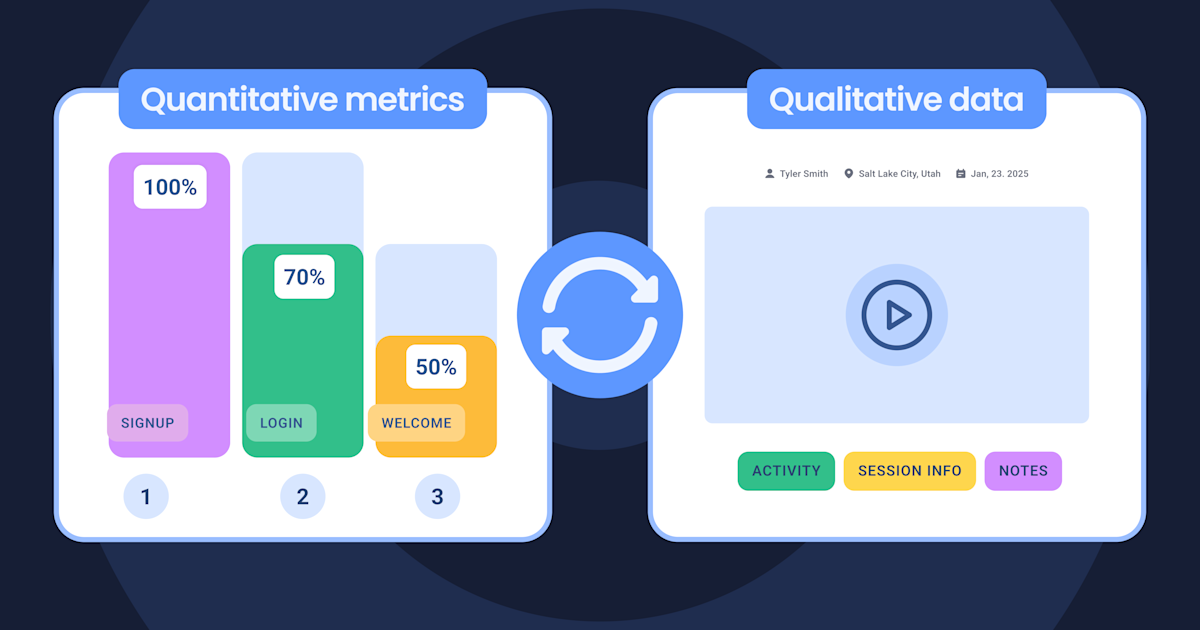

Most analytics tools force you to jump between dashboards, spreadsheets, and session replay apps to piece together a full picture. UXCam removes that friction with a native connection between product analytics and session replay, all from a single SDK. This means:
Spot a drop in your funnel? Jump straight into session replays of affected users.
See unusual behavior in a report? Click into sessions without losing context.
Want to analyze rage clicks or abandoned flows? Filter and view instantly.
Quick to set up, easy to use
Because of our autocapture technology, you don’t need to set up every single thing you want to track—insights just start showing up right away. You’ll also get access to ready-made filters and report templates, so there’s no need to build complex dashboards from scratch. And if you're working with a team, it’s easy to share dashboards with others so everyone—product, design, and engineering—is on the same page.
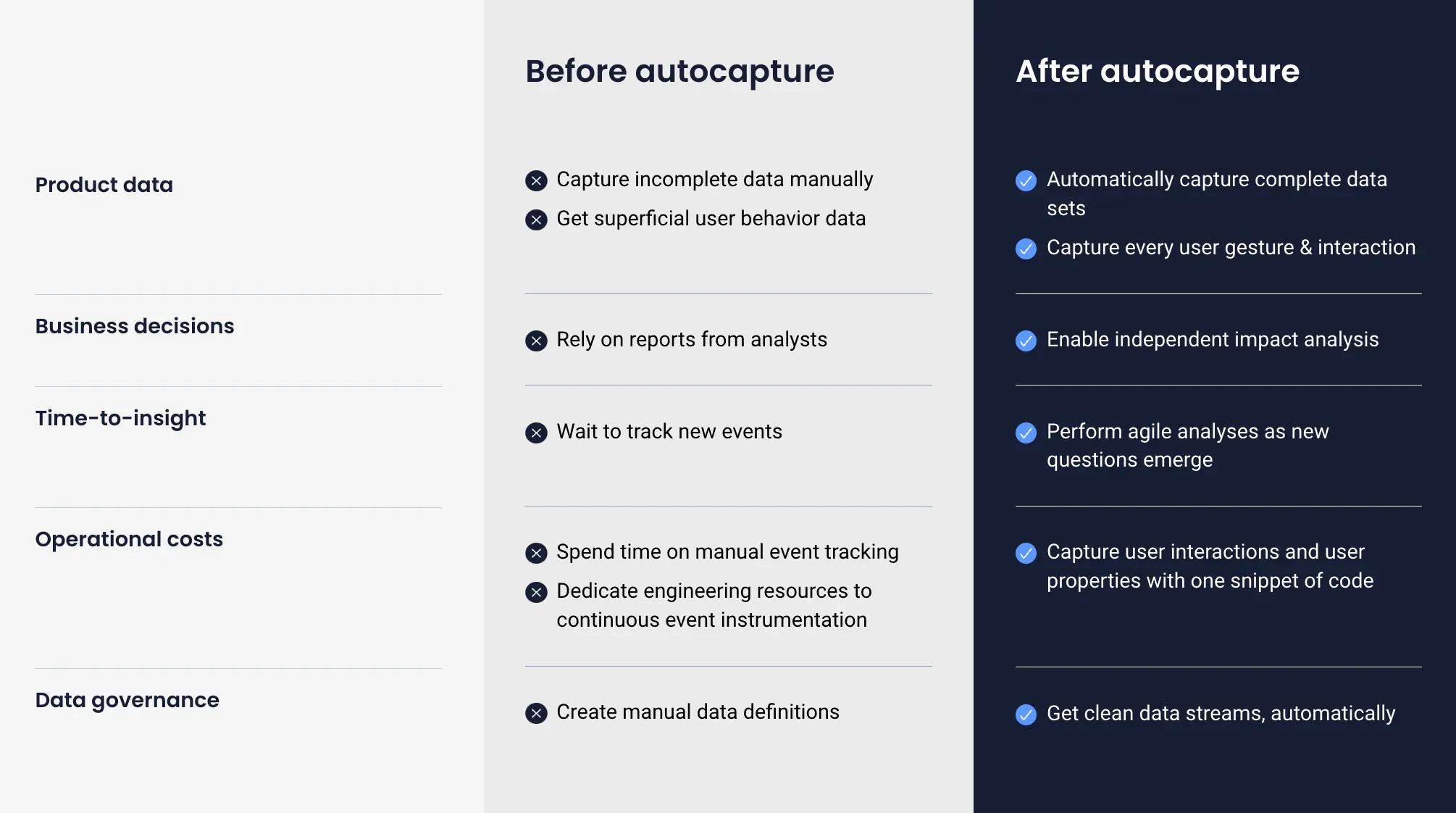
Flexible, but not overwhelming
Even though UXCam is simple to use, it still gives you the flexibility to go deeper when you need to. It covers most of the common product analytics use cases right out of the box, but you can also set up custom events and filters to answer more specific questions.

Get insights in a few click
One of the most powerful advantages is how quickly UXCam gets you to insight. With just a few clicks, you can segment sessions based on user behavior, generate dashboards from a specific cohort, or jump directly into sessions tied to key events. You’ll even uncover patterns and friction points you might not have thought to track—surfacing insights that traditional, manual analytics setups often miss.
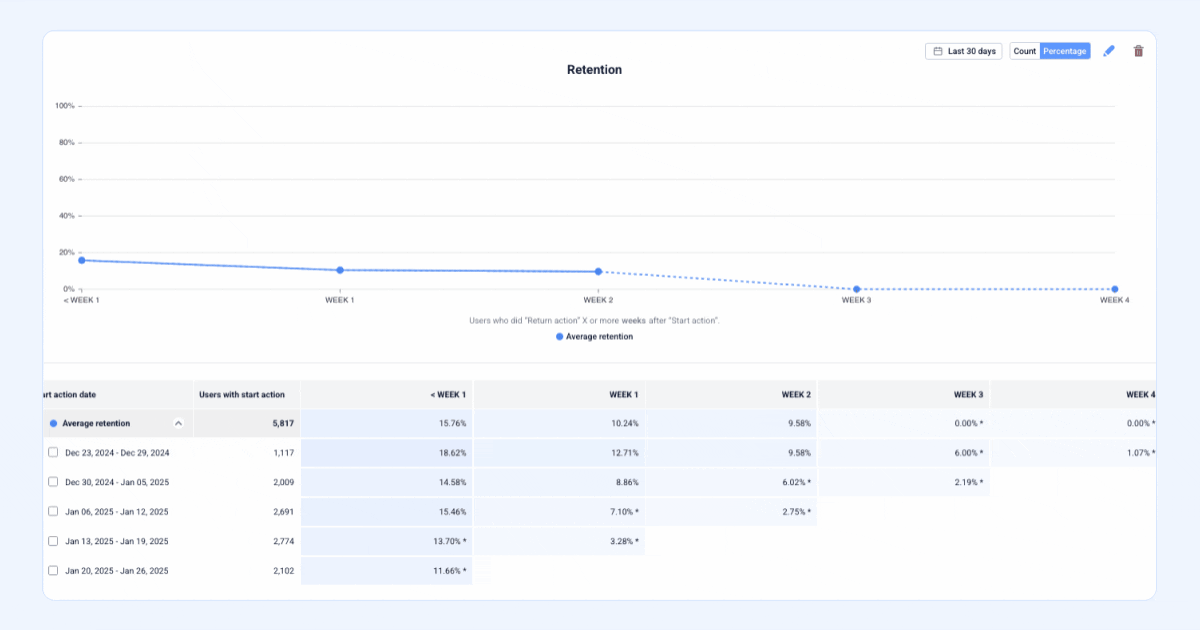
Ready to level up your web analytics reporting? Sign up for FREE to start using UXCam to capture rich behavioral insights, fix friction points, and increase your conversion rates.
Here's a quick demo of UXCam:
2. Optimize website speed and performance
A sluggish website can deter potential customers. Ensure your site loads swiftly by compressing images, minifying CSS and JavaScript, and utilizing browser caching. Tools like Google PageSpeed Insights can help identify performance bottlenecks. Faster websites keep users engaged and reduce bounce rates, paving the way for higher conversions.
3. Personalize the user experience
Tailored experiences resonate more with users. Utilize data to customize content, product recommendations, and offers based on user behavior and preferences. Personalization makes visitors feel valued and understood, which boosts engagement and conversion rates.
4. Use clear and compelling calls to action
Your calls to action (CTAs) guide users toward desired actions. Make them stand out with contrasting colors and concise, action-oriented text like “Get Started” or “Buy Now.” Position CTAs strategically on every page, especially near key content sections, to facilitate seamless user journeys toward conversion.
5. Simplify navigation for better usability
Complex navigation can frustrate visitors. Streamline your menu by categorizing content logically and using clear labels. Implement a search bar to help users find what they need quickly. Intuitive navigation enhances user experience, making it easier for visitors to locate and engage with your offerings.
6. Incorporate high-quality visuals and videos
Visual content grabs attention and conveys messages efficiently. Use professional images and engaging videos to showcase your products or services. High-quality visuals not only enhance aesthetic appeal but also build trust and credibility, encouraging users to take the next step. You can also embed Instagram feed on your blog where necessary to display fresh, engaging content from your social media, making your site more interactive and visually appealing.
7. Leverage social proof
Social proof reinforces trust and reliability. Display customer testimonials, reviews, and case studies prominently on your site. Highlighting positive experiences from others assures new visitors that they’re making a sound decision, thereby increasing the likelihood of conversion. Additionally, include security badges, payment seals, or industry certifications to key pages like checkout or sign-up forms. These signals reassure users that their information is safe.
8. Simplify forms and reduce friction
Long, complicated forms can deter users from completing actions. Limit form fields to essential information only. Use multi-step forms if necessary to make the process feel less overwhelming. Simplifying forms reduces friction and increases the chances of users completing them.
9. Conduct A/B testing
A/B testing allows you to compare different versions of your web pages to see which performs better. Test elements like headlines, images, CTAs, and layouts. Analyzing results from A/B tests provides actionable insights to optimize your site for higher conversions continuously.
10. Implement live chat or AI chatbots
Instant support can significantly enhance user experience. Implement live chat or AI-powered chatbots to answer questions and guide users in real-time. Providing immediate assistance helps resolve doubts promptly, increasing the likelihood of conversions.
11. Use Urgency and scarcity tactics
Creating a sense of urgency can prompt users to act quickly. Use countdown timers for limited-time offers or highlight low stock levels to encourage immediate purchases. These tactics can effectively drive users to make decisions faster, boosting conversion rates.
12. Ensure mobile responsiveness
With a growing number of users browsing on mobile devices, having a mobile-responsive website is crucial. Ensure your site adapts seamlessly to different screen sizes and maintains functionality across all devices. A smooth mobile experience enhances user satisfaction and drives conversions.
13. Craft persuasive web copy
Your website’s copy should be clear, concise, and persuasive. Focus on the benefits your products or services offer and address your audience’s pain points. Effective copywriting engages users and motivates them to take the desired action, whether it’s signing up, purchasing, or contacting you.
14. Offer guarantees or risk reversals
Reducing perceived risk can encourage users to convert. Offer guarantees such as money-back promises or free trials to reassure customers about their purchase decisions. These assurances can alleviate doubts and make users more confident in completing transactions.
15. Retarget visitors with personalized ads
Not all visitors convert on their first visit. Use retargeting ads to re-engage those who showed interest but didn’t convert. Personalized ads remind them of your offerings and can lead them back to your site, increasing the chances of conversion upon their return.
16. Utilize exit-intent popups
Exit-intent popups appear when a user is about to leave your site. Use them to offer discounts, free resources, or newsletter sign-ups to capture their interest one last time. These popups can effectively convert hesitant visitors before they exit.
Website conversion rates benchmarks and industry insights
| Metric | Conversion Rate | Details |
|---|---|---|
| General Average Conversion Rate | 2.35% | Average across all industries; 2-3% is acceptable for most websites. |
| Top Websites Conversion Rate | 11%+ | Top-performing websites achieve 11% or more |
| Best Industry Conversion Rate | 7.90% | Food & Beverage industry has the highest conversion rate among all sectors. |
| Highest B2B Conversion Rate | 4.60% | Professional services have the highest conversion rate in B2B industries. |
| Highest B2B Form Conversion Rate | 2.80% | The industrial niche leads in form conversion rates within B2B. |
How do you calculate website conversion
A conversion rate is the percentage of website visitors who complete a specific goal or action. It’s a key metric that shows how effectively your website turns traffic into results, such as purchases, sign-ups, or downloads.
The formula for calculating conversion rate is simple:
Conversion Rate = (Number of Conversions / Total Number of Visitors) x 100%
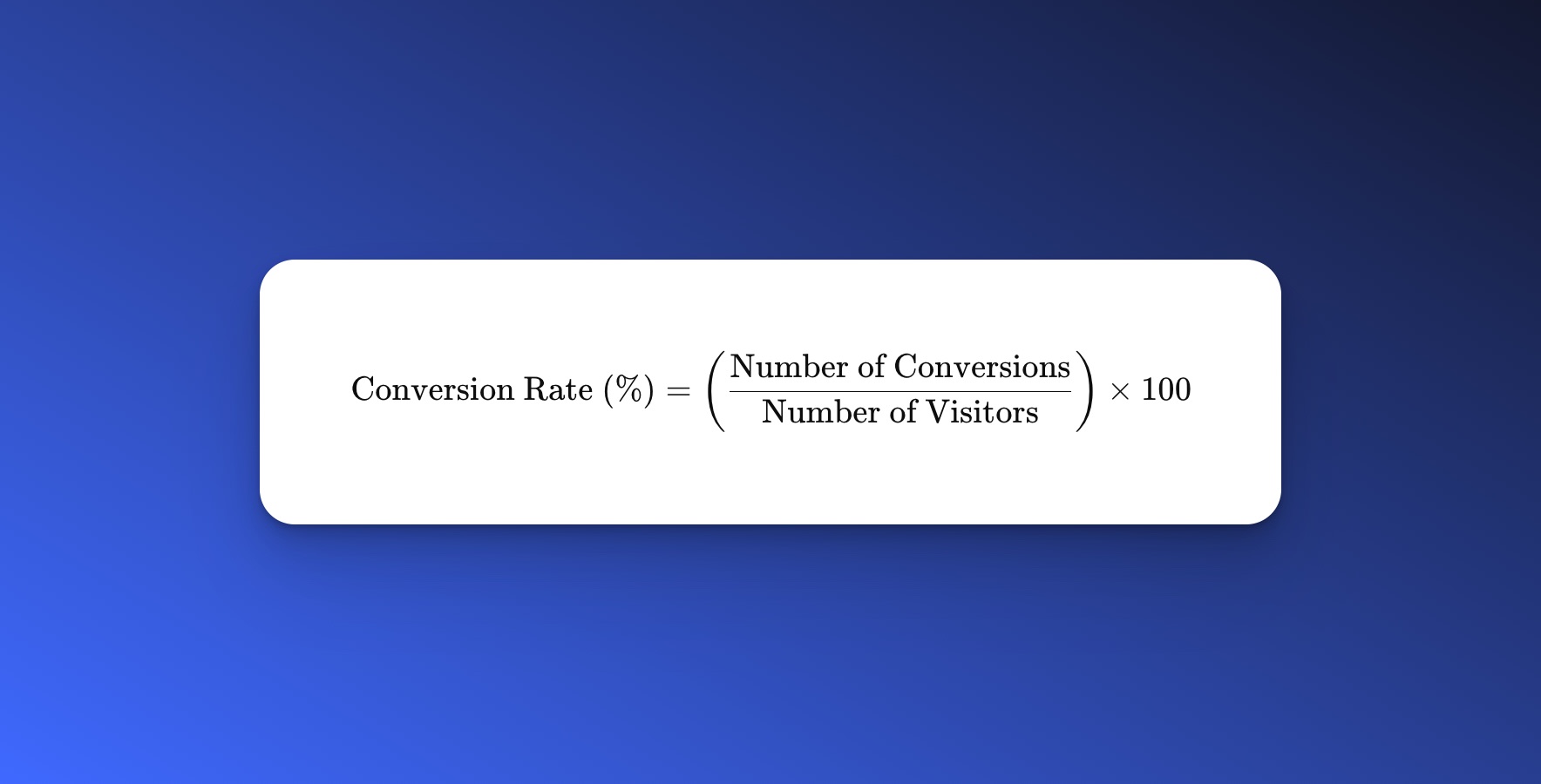

High conversion rates indicate that your website is meeting visitor expectations and guiding them toward desired actions. Low rates suggest there may be obstacles preventing users from completing your goals. Let's take a look at some examples;
Example 1: Newsletter Sign-Ups
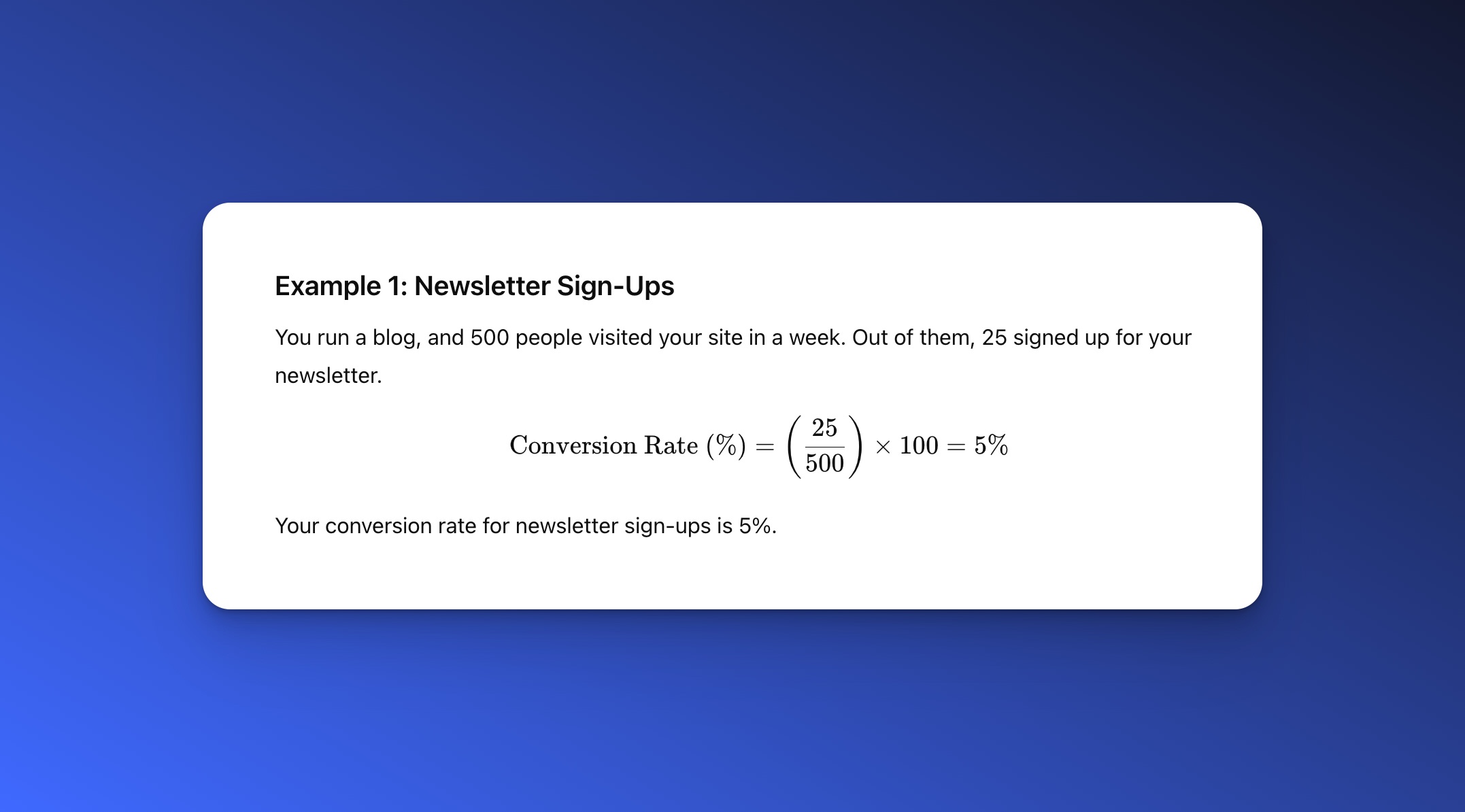

Example 2: Product Purchases
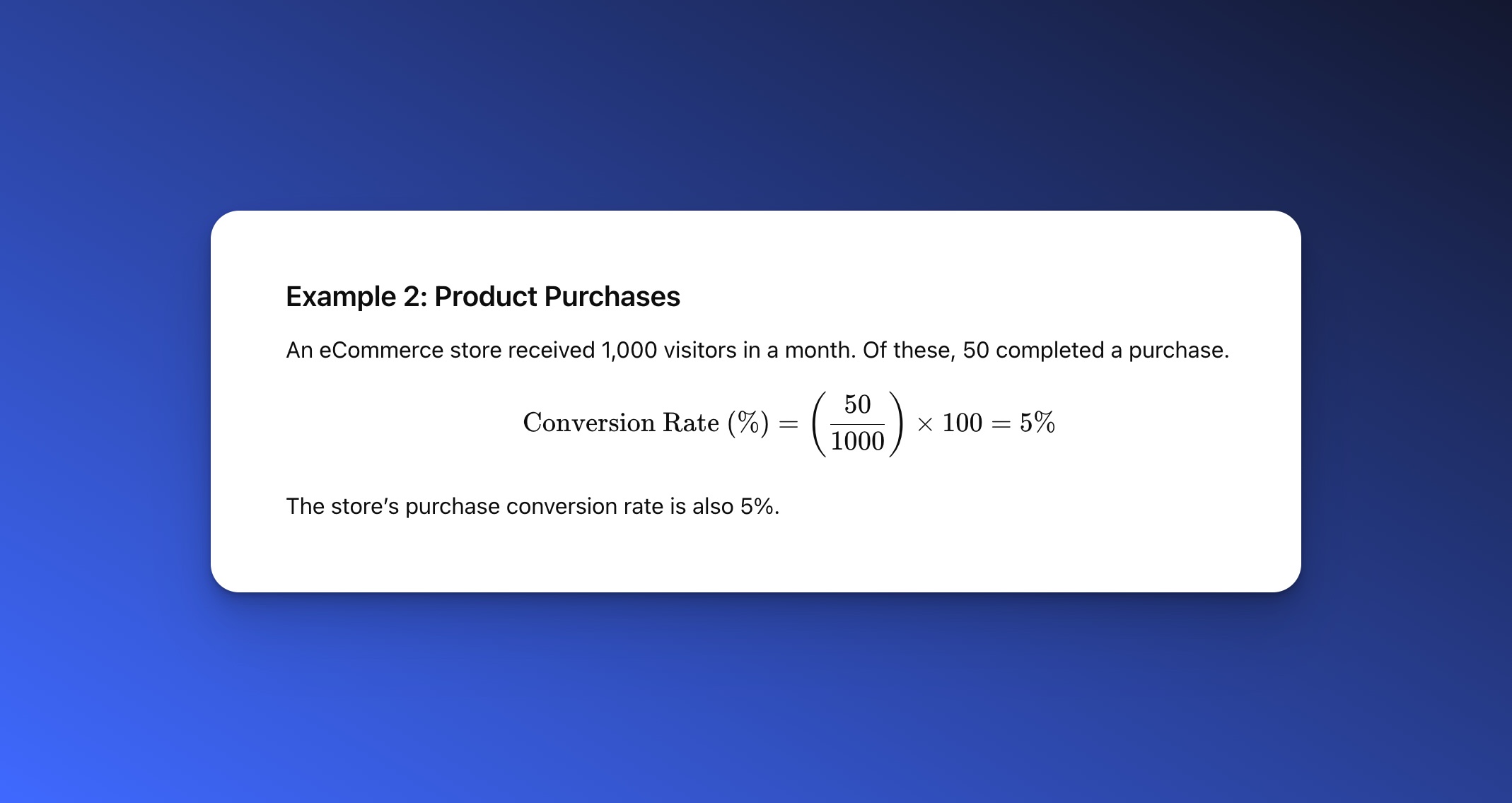

Example 3: Free Trial Sign-Ups
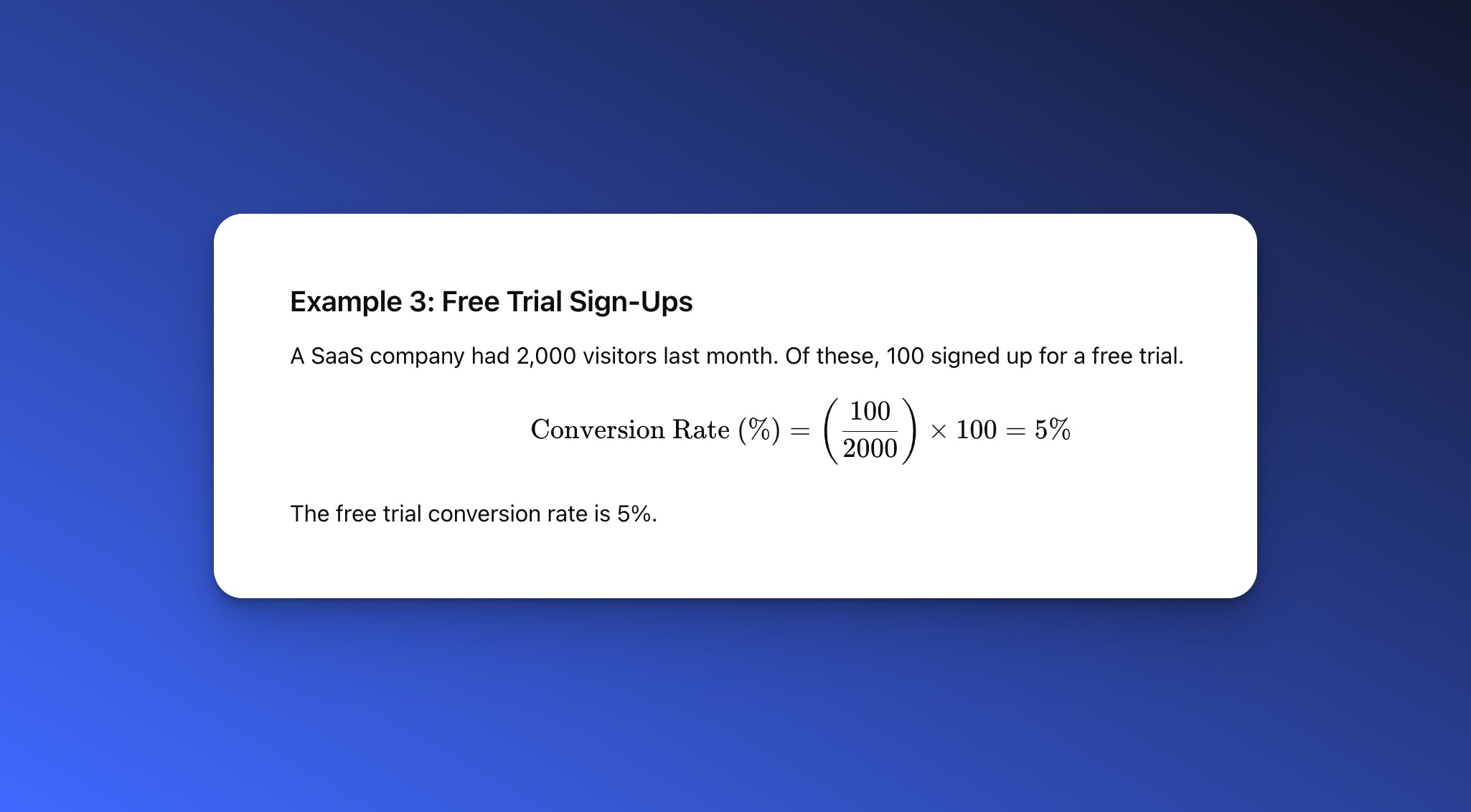

Types of website conversions
Website conversions can be divided into two main types: micro-conversions and macro-conversions. Each plays a critical role in understanding and improving how visitors interact with your site and progress toward your business goals.
Comparing micro-conversions vs. macro-conversions
| Aspect | Micro-Conversions | Macro-Conversions |
|---|---|---|
| Definition | Small actions indicating engagement | Primary goals directly tied to revenue |
| Examples | Newsletter sign-ups, ebook downloads | Purchases, subscriptions |
| Impact | Provide insights into user behavior | Directly contribute to business goals |
What are micro-conversions?
Micro-conversions are small, incremental actions visitors take that indicate interest or engagement. These actions often serve as steps toward larger goals but are valuable on their own because they reflect a visitor’s intent to move forward.
Examples of Micro-Conversions:
Signing up for a newsletter
Downloading an ebook or guide
Adding a product to a shopping cart
Watching a video or webinar
Clicking on a call-to-action (CTA) button
Micro-conversions provide insight into how users engage with your content. They help you identify bottlenecks in your conversion funnel and refine your strategy to encourage more significant actions.
What are macro-conversions?
Macro-conversions are the primary goals of your website—the big actions that directly align with your business objectives. These represent the ultimate outcome you want visitors to achieve when interacting with your site.
Examples of Macro-Conversions:
Completing a purchase
Subscribing to a paid service
Submitting a request for a quote
Booking a consultation or demo
Macro-conversions are key performance indicators (KPIs) for your website. Tracking these conversions helps measure success and informs whether your website is delivering the results you need.
Website conversion examples by business goals
Understanding the specific goals of your website is crucial for measuring its success. Different objectives require different types of user actions, known as conversions.
Below is a table that highlights common business goals and the corresponding examples of conversions to help you align your strategy with measurable outcomes.
| Business Goal | Example Conversions |
|---|---|
| Generate Sales | Completed purchases, added items to cart |
| Build a Mailing List | Newsletter sign-ups, content downloads |
| Increase Engagement | Video views, time spent on page |
| Gather Leads | Contact form submissions, free trial sign-ups |
Conclusion
Boosting your website conversions is entirely achievable.By applying these 16 strategies, you transform your site into a powerful tool that not only attracts visitors but also turns them into loyal customers.
You enhance user experience, build trust, and guide visitors seamlessly toward taking action.Monitoring your analytics and gathering user feedback ensures you stay on the path of continuous improvement.
Take charge of your website’s performance and watch your conversion rates soar.Don’t miss out on the opportunity to optimize your site with the best tools available.
Sign Up for the UXCam for Web Waitlist
FAQs
Understanding Website Conversions FAQs
How do website conversions work?
Website conversions happen when elements such as design, messaging, user experience, and calls-to-action work together to guide a visitor toward completing a specific goal. Successful conversions rely on understanding user intent and delivering a smooth, persuasive journey from entry to action.
What metrics are used to measure website conversions?
Metrics used to evaluate website conversions typically include conversion rate, bounce rate, average session duration, form completion rate, and abandonment rate. These indicators help assess how well the site drives action and where improvements are needed.
How can you improve website conversions?
Improving website conversions involves identifying barriers to action, understanding user behavior, and refining touchpoints across the user journey. This includes optimizing page speed, clarifying messaging, enhancing trust elements, and ensuring that each page supports a clear and compelling action.
What tools help improve website conversions?
Website conversion improvement is supported by tools that track behavior, analyze user interactions, and test different experiences. Platforms like UXCam provide detailed insights into how users engage with pages, helping businesses make data-informed changes that lead to better outcomes.
What is a good conversion rate for a website?
A good conversion rate for a website typically ranges between 2% and 5%, but it can vary based on the industry, traffic source, and type of conversion. What matters most is not the average but whether the current rate aligns with business goals and shows consistent improvement through optimization efforts.
You might also be interested in these;
What is Web Analytics? Definition, Metrics & Best Practices
Web Analytics Reporting - How to Create Actionable Reports
Website Visitor Tracking - A Comprehensive Guide
Top 10 Digital Analytics Tools You Need to Know
Ultimate Website Optimization Guide: Must-Know Tactics
Website Analysis 101: How to Analyze for Peak Performance
AUTHOR

Tope Longe
Product Analytics Expert
Ardent technophile exploring the world of mobile app product management at UXCam.
What’s UXCam?
Related articles
Website Optimization
AI Conversion Rate Optimization - What It Is & How It Works
Boost your website performance with AI Conversion Rate Optimization. Learn how AI tools analyze behavior, personalize UX, and increase conversions...

Tope Longe
Product Analytics Expert
Website Optimization
10 Best Landing Page Optimization Tools
Boost conversions with the 10 best landing page optimization tools. Compare features, pricing, and use cases for growth-focused...

Tope Longe
Product Analytics Expert
Website Optimization
How to Improve User Experience on Website
Improve website UX with 10 proven tips for product managers. Learn how to spot issues, reduce friction, and boost conversions using UXCam for...

Tope Longe
Product Analytics Expert